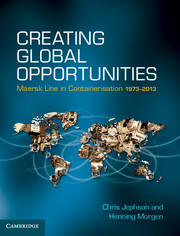Book contents
- Frontmatter
- Dedication
- Contents
- List of figures
- List of tables
- List of Economist Intelligence Unit data
- List of boxes
- Acknowledgements
- Glossary
- Prologue
- 1 ‘Per Aspera Ad Astra’
- 2 The Coming Revolution
- 3 The Decision
- 4 Building the Base (1978–1984)
- 5 Planning the Next Steps (1984–1987)
- 6 Laying the Foundations for Expansion (1987–1990)
- 7 The 1990s
- 8 The Acquisition Trail (1992–1998)
- 9 1999 A Year of Developments and Acquisitions
- 10 Into the New Millennium (2000–2005)
- 11 P&O NedLloyd (2005–2007)
- 12 A New Strategy (2008–2013)
- Epilogue
- Notes and References
- Index
12 - A New Strategy (2008–2013)
StreamLINE and Beyond
Published online by Cambridge University Press: 05 April 2014
- Frontmatter
- Dedication
- Contents
- List of figures
- List of tables
- List of Economist Intelligence Unit data
- List of boxes
- Acknowledgements
- Glossary
- Prologue
- 1 ‘Per Aspera Ad Astra’
- 2 The Coming Revolution
- 3 The Decision
- 4 Building the Base (1978–1984)
- 5 Planning the Next Steps (1984–1987)
- 6 Laying the Foundations for Expansion (1987–1990)
- 7 The 1990s
- 8 The Acquisition Trail (1992–1998)
- 9 1999 A Year of Developments and Acquisitions
- 10 Into the New Millennium (2000–2005)
- 11 P&O NedLloyd (2005–2007)
- 12 A New Strategy (2008–2013)
- Epilogue
- Notes and References
- Index
Summary
For shipping, all stands and falls with worldwide macroeconomic conditions.
UNCTAD, Review of Maritime Transport, 2011The A.P. Moller – Maersk Group made its first loss ever in 2009, after 104 years in business. Maersk Line’s loss of $2.1 billion was highly influential in the group’s overall loss of $1 billion, highlighting the close connection between the macroeconomic state of the world and shipping – in this case container shipping.
More formally, the A.P. Moller – Maersk Group’s Annual Report stated that:
2009 was a challenging year in which most of the world was, to a greater or lesser extent, affected by the financial and economic crisis . . . Consumption and investments slowed down dramatically, with a negative impact on world trade.
Maersk Line’s loss reflected ‘the tough market conditions with falling freight rates and volumes’. The immediate effect of the significantly changed supply and demand situation was a dramatic decline in turnover of some $8 billion from 2008 to 2009.
Maersk Line’s turnover as a business had grown over 600 per cent in the ten years between 1997 and 2007, to about $26 billion. A further $2 billion would be added in 2008. Maersk Line was now a massive business and turning its result around to consistent profitability was not going to be a short-term activity.
- Type
- Chapter
- Information
- Creating Global OpportunitiesMaersk Line in Containerisation 1973–2013, pp. 328 - 361Publisher: Cambridge University PressPrint publication year: 2014



